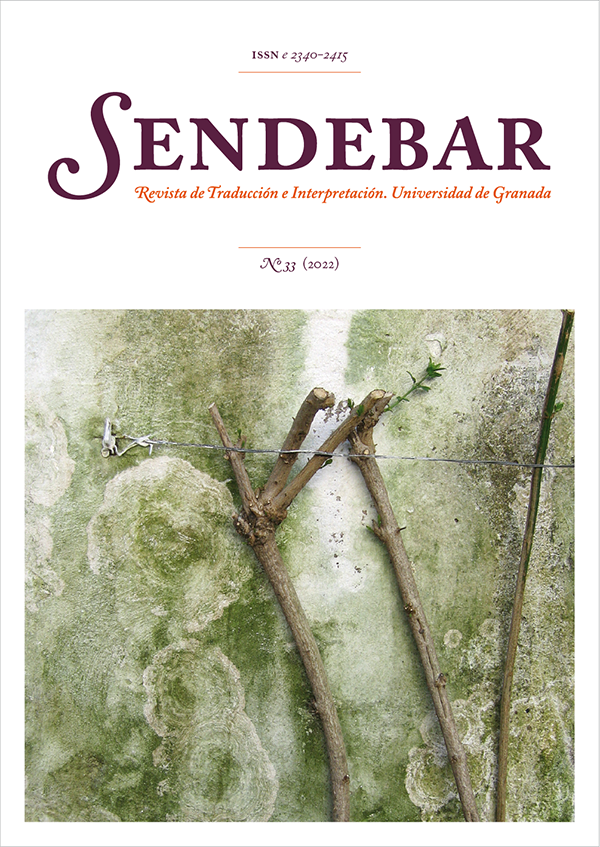The Success of La novia de Cervantes, The First Anthology of Azorín in Chinese. A Textual Comparison between Spanish, French and Chinese
DOI:
https://doi.org/10.30827/sendebar.v33.18141Abstract
This paper studies the most edited anthology of Azorín in Chinese, La novia de Cervantes, on the basis of “Perfect Translation” Theory. After the introduction and theoretical framework, the paper is organized into two different parts: firstly, a brief presentation of the diffusion of Azorín in China, the historical background of, La novia de Cervantes, and its reception; secondly, a contrastive analysis of the translation, which is divided into three categories: the equivalences of form, meaning and intention. The results show that the translators have managed to preserve stylistic features and aesthetic peculiarities of Azorín, recreating in this way the literariness in the target text, which is considered a fundamental reason for the success of, La novia de Cervantes.
Downloads
References
Azorín. (1947). Obras completas de Azorín. Aguilar.
Berrio, A. (1989). Teoría de la literatura. Cátedra.
Bian, Zhilin. (1943). 阿左林小集 [Una compilación de relatos de Azorín]. Guomin Tushu
Catenaro, B. (2008). La obra literaria: Posibilidades y límites del traductor. Espéculo. Revista de Estudios Literarios, (37).
Chen, Huiting y Jiang, Xiaozhuo. (2021). 民国文人的西班牙文学译介活动及其价值 (1912- 1949) [Literati' s Translation Activities of Spanish Literature in the Period of Republic of China and Its Value (1912-1949)]. The Science Education Article Collects, (29).
Chen, Qiaoxi. (2021). La traducción de la obra de Azorín al chino y su influencia en la literatura china moderna y contemporánea. [Tesis doctoral, Universidad Complutense de Madrid]. https://eprints.ucm.es/id/eprint/66525/1/T42443.pdf
Ciruela, J. J. (2014). La “Propuesta para la fundación de un Instituto de Traducción” (1894) de Ma Jianzhong y su contribución a la teoría de la traducción en China. SENDEBAR. Revista de Traducción e Interpretación, 25, 87-108. https://revistaseug.ugr.es/index.php/sendebar/article/view/341
Dai, Wangshu y Xu, Xiacun. (1930). 西万提斯的未婚妻 [La novia de Cervantes]. Shenzhou Guoguang
Dai, Wangshu y Xu, Xiacun. (1982). 西班牙小景 [Paisaje de España]. Fujian Renmin.
Douban. (s. f.). 塞万提斯的未婚妻 [La novia de Cervantes]. https://book.douban.com/subject/20453483/
Douban. (s. f.). 西班牙小景 [Paisaje de España]. https://book.douban.com/subject/3531878/
Fan, Ruihua y Xu, Zenghui. (1988). 卡斯蒂利亚的花园 [El jardín de Castilla]. Zuojia.
Fernández, R. (Noviembre 9 de 2017). Azorín, la fama postuma. Blogger. http://blogderamonfernandez.blogspot.com/2017/11/exposicion-azorin-la-fama-postuma-sala.html
García, A. (1989). Teoría de la literatura. Cátedra.
Gil-Cepeda, M. (1994). Sobre la traducción, sus problemas y la intervención de la subjetividad del traductor. Docencia e Investigación, (2), 77-88.
Gómez, N. (2004). El problema del tiempo en Azorín: Doña Inés. Espéculo. Revista de Estudios Literarios, (26), http://www.ucm.es/info/especulo/numero26/dines.html
González, A. (2015). La traducción de Doña Inés de Azorín por Georges Pillement en F. Navarro (Ed.) Azorín y Miró en traducción. Universidad de Alicante.
González, P. (2010). Poesía completa (60 poemas) de Li Qingzhao. Ediciones del oriente y del mediterráneo.
Hao, Xi. (18 de abril de 2018). 愿你永远是未婚妻的脸 [Que tengas cara de novia para siempre]. Douban. https://book.douban.com/review/9304839/
Hu, Shi. (1918). 建设的文学革命论 [Una revolución literaria constructiva], 新青年 [Nueva Juventud], 4(4), 289-306.
Jiménez, L. (1998). Azorín, pequeño filósofo vitalista. Anales del Seminario de Hisitoria de la Filosofía, 15, 223-242.
Jin, Kemu. (2008). 人生与学问 [La vida y el saber]. Shaanxi Normal University.
Lee, G. (1989). Dai Wangshu: the life and poetry of a chinese modernist. The Chinese University Press. The Chinese University of Hong Kong.
Liu, Xia. (2018). An Analysis of Political Texts Translation from the Perspective of “Good Translation” in the Late Qing Dynasty——Based on the Chinese and English Versions of “Treaty of Nanjing” and “Treaty of Tianjin”, Journal of Changchun Normal University, 37 (3), 122-124.
Mao, Dun. (1923). 西班牙现代小说家巴洛伽 [Baroja, un novelista español modernista]. 小说月报 [Ficción Mensual], 14(5).
Martínez, J. (1979). Sobre algunos formantes de la expresión azoriniana. En A. G. Morell, A. Soria & N. Martín (Eds.), Estudios sobre literatura y arte dedicados al profesor Emilio Orozco Díaz (pp. 361-376). Universidad de Granada.
Mei Meilian. (2001). Ma Jianzhong and Equivalence in Translation. Journal of Lishui Teachers College, 23 (3), 40-42.
Navarro, F. (Ed.). (2015). Azorín y Miró en traducción. Universidad de Alicante.
Pan, Wenguo. (1997). Contrast of English and Chinese. Beijing Language and Culture University.
Pillement, G. (1929). Espagne. Les Éditions Rieder.
Relinque, A. (2008). El nacimiento de la literatura moderna. En D. Martínez-Robles y C. Prado-Fonts (Eds.), Narrativas chinas: Ficciones y otras formas de no-Literatura (pp. 117-163). Editorial UOC.
Rosa, A., Pięta, H. y Maia, R. (2017) Theoretical, methodological and terminological issues regarding indirect translation: An overview. Translation Studies, 10 (2), 113-132. https://www.tandfonline.com/doi/full/10.1080/14781700.2017.1285247
Sun, Min. (2021). Azorín en China. Anuari de Filología, Llengües I Literatures Modernes, 2021(11), 123-139. https://revistes.ub.edu/index.php/AFLM/article/view/37978/36530
Tan, Dingzhong y Duan, Zili. (2019). On Constructing Canons of Translated Literary Works. Journal of Jiaxing University, 31(3), 83-87.
Wang, Hongtao. Transition and Evolution of the Translation Theories in Chinese Tradition: Critique of the “Perfect Translation” Theory by Ma Jianzhong from a Modern Perspective. Foreign Language Research, 2005 (1), 89-94.
Wang, Zengqi (1993). 汪曾祺文集·文论卷 [Obras completas de Wang Zengqi-Tomo de críticas literarias]. Jiangsu Wenyi.
Washbourne, K. (2013). Nonlinear Narratives: Paths of Indirect and Relay Translation. Meta, 58(3), 607–625. https://doi.org/10.7202/1025054ar
Wood, D. (1-3 de diciembre de 2011). Referencias clásicas en Castilla: Alusiones, citas, resumen. [Presentación en conferencia]. Coloquio internacional de los clásicos redivivos y los universales renovados, Pau, Francia.
Xu, Xiacun. (1928). 斗牛 [Los toros]. 无轨列车 [Tren sin Vías (Revista literaria)], (8).
Xu, Xiacun. (1929a). 一个绝世的散文家: 阿左林 [Azorín: un prosista trascendental]. 新文艺 [Nueva Literatura], 1(4).
Xu, Xiacun. (1929b). 二十年来的西班牙文学 [La literatura española en los pasados veinte años]. 小说月报 [Ficción Mensual].
Zou, Jinhong. (2011) Comparison of Nida’s and Ma Jianzhong’s Translation Theories. Journal of Inner Mongolia Agricultural University (Social Science Edition),2011 (2) : 361-362, 364.
Zhang, Yang y Gong, Zhao. (2008). On Equivalence Conception in Ma's Theory. Journal of Anhui Radio and TV University, 2008 (1), 75-78.
Zhou, Zuoren. (1930). 西班牙的古城 [Las viejas ciudades de España]. 骆驼草 [Hierba de Camello (revista literaria)],(3).
Downloads
Published
How to Cite
Issue
Section
License
Terminos de Licencia Sendebar.

















